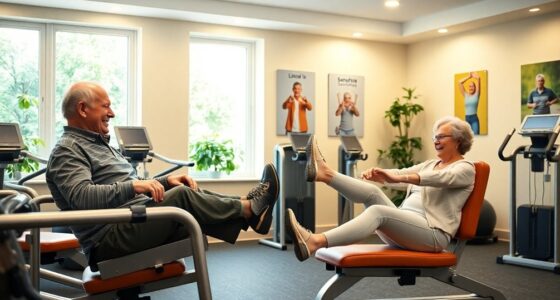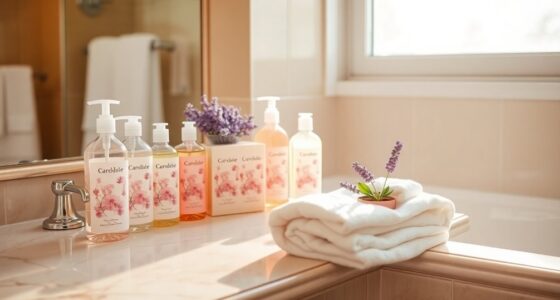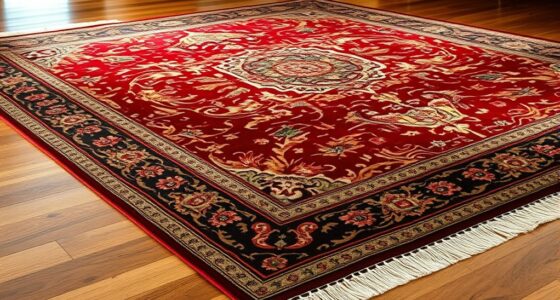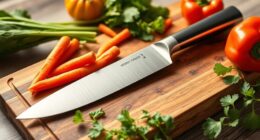Gardening can be enjoyable and accessible for you as a senior. Start by planning your garden for easy access, using raised beds or containers. Choose ergonomic tools that reduce strain. Focus on low-maintenance plants that thrive in your climate. Keep pathways safe and clear to prevent tripping. Enlist help for heavy tasks, and maintain a positive attitude to celebrate small successes. There's so much more to explore that can enhance your gardening experience.
Key Takeaways
- Use raised beds 24 to 30 inches high and no wider than 3 to 4 feet for easier access and comfortable tending.
- Incorporate ergonomic tools with curved grips and lightweight designs to minimize strain while gardening.
- Install a drip irrigation system for efficient, targeted watering without frequent manual checks.
- Choose low-maintenance, drought-resistant plants that thrive in your local climate for less upkeep.
- Maintain at least 3 feet between beds and create solid pathways to ensure safe maneuverability.
Plan Your Garden for Accessibility

When planning your garden, keep accessibility in mind to guarantee you can enjoy your space without strain.
Using raised beds that are 24 to 30 inches high allows you to tend to your plants while standing or sitting comfortably. Make sure the beds aren't wider than 3 to 4 feet, so you can easily reach everything without overextending.
Maintain at least 3 feet between beds for smooth maneuverability. Choose solid pathways made of brick or concrete to prevent tripping hazards and make certain they're level and clear of debris.
Finally, position your raised beds in areas that receive 6 to 8 hours of sunlight daily, promoting healthy growth for your sun-loving plants.
Choose Ergonomic Tools

To make your gardening experience more enjoyable, you should consider using ergonomic tools specifically designed for comfort and ease of use.
These tools, with curved grips and lightweight materials, minimize hand and wrist strain, making them ideal for seniors with limited strength or dexterity. Long-handled weeders and trowels allow you to maintain a comfortable posture, reducing the need for bending or kneeling.
Many ergonomic gardening tools cater to those with arthritis, featuring soft grips that enhance comfort and efficiency.
When selecting tools, it's important to test them for comfort and ease of use; verify the grip fits well in your hand and that you can maneuver the tools effectively before you make a purchase.
Enjoy gardening without the strain!
Utilize Raised Beds and Containers

Using raised beds and containers can make gardening much easier for you.
With the right height and drainage, you won't have to bend down or worry about overwatering your plants.
Plus, being able to move your containers means you can always work at a comfortable level.
Easy Access Gardening
Creating a garden that's easy to access can transform the gardening experience for seniors, allowing you to enjoy the benefits without the strain.
Adaptive gardening techniques, like using raised beds constructed at 24 to 30 inches, let you garden comfortably whether seated or standing. If you use tabletop gardens around 27 inches high, they can accommodate wheelchair users, addressing mobility issues effectively.
Container gardening is also a great option; choose lightweight pots with drainage holes to prevent root rot. Consider self-watering pots to minimize maintenance and keep your plants thriving.
Improved Drainage Solutions
Accessing your garden easily is just the beginning; guaranteeing your plants thrive requires effective drainage solutions.
Consider using raised beds that are 24 to 30 inches high. Make sure they include drainage holes and are built with rot-resistant materials to manage water effectively. This height allows you to garden comfortably, whether seated or standing, while promoting proper drainage and reducing the risk of overwatering.
Containers are another great option. Choose lightweight materials like plastic and guarantee they've drainage holes to prevent root rot.
You might also want to install self-watering pots to maintain consistent moisture levels, which cuts down on frequent watering. Regularly check the top 2 inches of soil to avoid waterlogging and keep your plants healthy. Additionally, effective drainage is crucial for home security systems, as it prevents potential water damage to sensitive equipment placed outdoors.
Implement Efficient Watering Systems

To make watering your garden easier, consider installing a drip irrigation system that delivers water right where it's needed.
Self-watering pots are another great option, providing consistent moisture for your plants without the hassle of frequent watering.
These efficient systems can save you time and effort while keeping your garden thriving.
Utilize Drip Irrigation
Drip irrigation systems can revolutionize the way you water your garden, making it easier and more efficient. These systems deliver water directly to your plant roots, ensuring excellent moisture retention while minimizing water waste.
For seniors, drip irrigation is particularly accessible; it can be set up at a height that allows you to manage it from a seated position or standing. Plus, you can install timers for consistent watering without the need for constant checks or physical effort.
Install Self-Watering Pots
Whether you're nurturing herbs on a windowsill or cultivating flowers on your patio, installing self-watering pots can simplify your gardening experience.
These pots come equipped with a reservoir that allows plants to absorb water as needed, ensuring consistent hydration without frequent watering. This is especially helpful for seniors with limited mobility, as many self-watering pots feature lightweight containers that are easy to manage.
A wicking system draws moisture up from the reservoir, preventing overwatering and root rot, which boosts plant health. Plus, clear indicators show when the water level is low, making monitoring a breeze.
Focus on Low-Maintenance Plants

While gardening can be a rewarding hobby, it's vital to choose plants that won't overwhelm you with maintenance. Low-maintenance perennials, like daylilies and sedum, bloom year after year without needing replanting. Incorporating native plants enhances biodiversity and requires less water and fertilizer. Drought-resistant varieties, such as lavender and ornamental grasses, minimize watering while adding visual appeal. Shrubs like boxwoods and hydrangeas provide structure and color with minimal care. Focus on plants that thrive in your local climate to guarantee successful growth and reduce the need for constant monitoring.
| Plant Type | Benefits | Examples |
|---|---|---|
| Perennials | Continuous blooms | Daylilies, Sedum |
| Native Plants | Low water/fertilizer needs | Coneflower, Black-eyed Susan |
| Drought-Resistant | Minimal watering | Lavender, Ornamental Grasses |
| Low-Upkeep Shrubs | Structure and color | Boxwoods, Hydrangeas |
Keep Pathways Safe and Clear

To guarantee a safe and enjoyable gardening experience, it's crucial to keep pathways clear and well-maintained. Confirm your pathways are made of solid surfaces like brick or concrete to reduce tripping hazards.
Make them at least 36 inches wide to allow easy navigation with walkers or wheelchairs. Regularly inspect and clear debris, such as leaves or branches, that could obstruct movement and lead to falls.
Consider using non-slip materials or treatments on pathways to enhance traction, especially in wet conditions. Installing handrails along steep or uneven pathways can provide additional support and stability as you move through your garden.
Enlist Help for Heavy Tasks

Maintaining a safe garden environment is only part of the equation; tackling heavy tasks can be another challenge altogether. To avoid injuries and strain, it's wise to enlist help for those demanding chores.
Involve family members or friends, turning labor into a bonding experience. You might also consider recruiting younger individuals, like grandchildren or neighbors, who've the physical strength to lift soil bags or move large planters.
Don't overlook community resources; local gardening clubs or volunteer groups often provide support for seniors needing assistance.
If the workload feels overwhelming, hiring local landscapers can relieve you of the physical burdens, allowing you to focus on the gardening aspects you love most.
Maintain a Positive Attitude
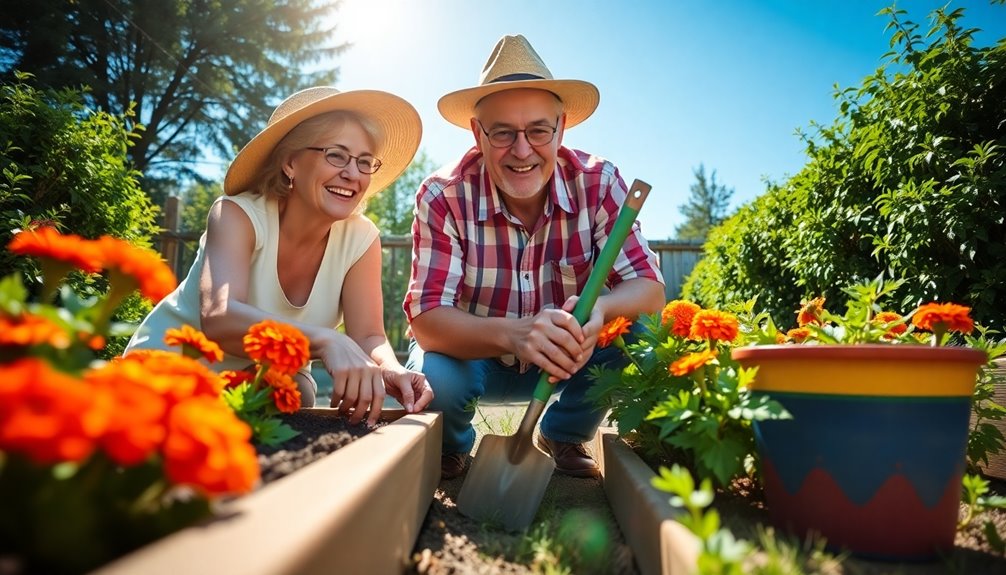
Gardening can be a source of joy and tranquility, and nurturing a positive attitude makes the experience even more rewarding. Embrace your physical limitations by setting achievable goals, allowing you to feel a sense of accomplishment. This boosts your self-esteem and promotes mental well-being.
A flexible mindset helps you adapt your plans, making gardening enjoyable rather than frustrating. Remember to celebrate small successes, like the first bloom or harvest, as these moments reinforce a positive perspective. Additionally, engaging in gardening with friends or family fosters social connections, creating a supportive environment that encourages shared enjoyment. By focusing on the joy gardening brings, you can enhance your experience and cultivate a more positive outlook on life. Furthermore, practicing self-reflection can help you identify what aspects of gardening bring you the most joy and fulfillment.
Frequently Asked Questions
How Do I Make My Garden Handicap Accessible?
To make your garden handicap accessible, build raised garden beds at 24 to 30 inches high, create wide, solid pathways, and use ergonomic tools.
You'll want to incorporate tabletop gardens for easy access and install handrails or ramps where needed.
Keep pathways clear of debris, ensuring they're at least 36 inches wide.
With these adjustments, you'll enhance accessibility and create a more enjoyable gardening experience for everyone involved.
What Is the Gardening 3 Year Rule?
The Gardening 3 Year Rule suggests you choose plants that thrive with minimal maintenance over three years.
By focusing on perennials and self-seeding varieties, you reduce the need for replanting and extensive care. This approach allows your garden to evolve and adapt, making it easier to manage over time.
What Gardening Tools Are Disability Friendly?
When you think about gardening, do you envision struggling with heavy, uncomfortable tools?
Disability-friendly gardening tools can change that. Opt for ergonomic designs with curved grips and padded handles to ease strain on your hands. Lightweight materials like aluminum can minimize fatigue, while long-handled tools let you work comfortably from a seated position.
Adaptive options, like ratchet pruners, enhance grip and efficiency, making your gardening experience enjoyable and accessible. You deserve that!
What Type of Garden Is Easiest for Elderly People to Use?
If you're looking to create a garden type that's easy to manage, consider raised beds. They let you garden without bending or kneeling, making it comfortable to reach your plants.
Tabletop gardens are also great, especially for herbs, as they're accessible from a seated position.
Container gardening offers flexibility, letting you move plants around easily.
Finally, vertical gardening maximizes space and keeps everything within reach, so you can enjoy your gardening experience fully.
Conclusion
By following these accessible gardening tips, you can cultivate a thriving garden without breaking a sweat. Remember, it’s all about working smarter, not harder. With the right tools and strategies, you can enjoy the fruits of your labor while keeping things manageable. Don’t hesitate to ask for help when you need it, and keep your spirits high. After all, gardening should be a joy, not a chore! So, roll up your sleeves and get planting! Additionally, make sure to incorporate elements that promote biodiversity, such as native plants and pollinator-friendly flowers. While you’re at it, remember to take breaks and appreciate the beauty around you, as it can be a soothing escape from the stresses of daily life. If you’re seeking information on various health topics, such as the doğum kontrol hapı etkileri, be sure to consult reliable sources to stay informed while you nurture your green oasis. Additionally, consider integrating sustainable practices like composting and rainwater collection to enhance your gardening experience while being kind to the environment. This not only boosts plant health but also contributes to a more resilient ecosystem. As you cultivate your garden, it’s essential to maintain a well-rounded approach to personal well-being, so remember to stay informed about various topics, including the doğum kontrol hapı etkileri, ensuring you prioritize both your garden and your health. Above all, let your gardening journey be filled with learning and joy!



